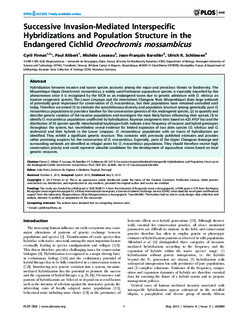| dc.contributor.author | Firmat, Cyril Joel Patrick | |
| dc.contributor.author | Alibert, P | |
| dc.contributor.author | Losseau, M | |
| dc.contributor.author | Baroiller, JF | |
| dc.contributor.author | Schliewen, UK | |
| dc.date.accessioned | 2015-11-20T11:09:48Z | |
| dc.date.accessioned | 2016-05-20T11:37:22Z | |
| dc.date.available | 2015-11-20T11:09:48Z | |
| dc.date.available | 2016-05-20T11:37:22Z | |
| dc.date.issued | 2013-05-09 | |
| dc.identifier.citation | PLoS ONE 2013, 8(5) | nb_NO |
| dc.identifier.issn | 1932-6203 | |
| dc.identifier.uri | http://hdl.handle.net/11250/2389914 | |
| dc.description.abstract | Hybridization between invasive and native species accounts among the major and pernicious threats to biodiversity. The
Mozambique tilapia Oreochromis mossambicus, a widely used freshwater aquaculture species, is especially imperiled by this
phenomenon since it is recognized by the IUCN as an endangered taxon due to genetic admixture with O. niloticus an
invasive congeneric species. The Lower Limpopo and the intermittent Changane River (Mozambique) drain large wetlands
of potentially great importance for conservation of O. mossambicus, but their populations have remained unstudied until
today. Therefore we aimed (1) to estimate the autochthonous diversity and population structure among genetically pure O.
mossambicus populations to provide a baseline for the conservation genetics of this endangered species, (2) to quantify and
describe genetic variation of the invasive populations and investigate the most likely factors influencing their spread, (3) to
identify O. mossambicus populations unaffected by hybridization. Bayesian assignment tests based on 423 AFLP loci and the
distribution of 36 species-specific mitochondrial haplotypes both indicate a low frequency of invasive and hybrid genotypes
throughout the system, but nevertheless reveal evidence for limited expansion of two alien species (O. niloticus and O.
andersonii) and their hybrids in the Lower Limpopo. O. mossambicus populations with no traces of hybridization are
identified. They exhibit a significant genetic structure. This contrasts with previously published estimates and provides
rather promising auspices for the conservation of O. mossambicus. Especially, parts of the Upper Changane drainage and
surrounding wetlands are identified as refugial zones for O. mossambicus populations. They should therefore receive high
conservation priority and could represent valuable candidates for the development of aquaculture strains based on local
genetic resources. | nb_NO |
| dc.language.iso | eng | nb_NO |
| dc.publisher | Public Library of Science | nb_NO |
| dc.rights | Navngivelse 3.0 Norge | * |
| dc.rights.uri | http://creativecommons.org/licenses/by/3.0/no/ | * |
| dc.title | Successive Invasion-Mediated Interspecific Hybridizations and Population Structure in the Endangered Cichlid Oreochromis mossambicus | nb_NO |
| dc.type | Journal article | nb_NO |
| dc.type | Peer reviewed | nb_NO |
| dc.date.updated | 2015-11-20T11:09:48Z | |
| dc.source.volume | 8 | nb_NO |
| dc.source.journal | PLoS ONE | nb_NO |
| dc.source.issue | 5 | nb_NO |
| dc.identifier.doi | 10.1371/journal.pone.0063880 | |
| dc.identifier.cristin | 1045673 | |
| dc.description.localcode | © 2013 Firmat et al. This is an open-access article distributed under the terms of the Creative Commons Attribution License, which permits unrestricted use, distribution, and reproduction in any medium, provided the original author and source are credited. | nb_NO |

